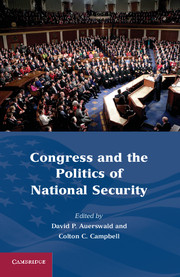Book contents
- Frontmatter
- Contents
- Figures and Tables
- Contributors
- Part One Historical and Institutional Challenges
- Part Two Oversight Challenges
- 4 Congress and Defense
- 5 Congress and Homeland Security
- 6 Congress and Intelligence
- 7 Foreign Aid Oversight Challenges for Congress
- Part Three Policy Challenges: Contours of Debate
- Works Cited
- Index
7 - Foreign Aid Oversight Challenges for Congress
from Part Two - Oversight Challenges
Published online by Cambridge University Press: 05 June 2012
- Frontmatter
- Contents
- Figures and Tables
- Contributors
- Part One Historical and Institutional Challenges
- Part Two Oversight Challenges
- 4 Congress and Defense
- 5 Congress and Homeland Security
- 6 Congress and Intelligence
- 7 Foreign Aid Oversight Challenges for Congress
- Part Three Policy Challenges: Contours of Debate
- Works Cited
- Index
Summary
U.S. foreign aid is a subset of U.S. foreign policy. It represents the largest component of the international affairs budget and is generally supported by foreign policy experts as an instrument, along with others, such as public diplomacy, defense, and the U.S. diplomatic corps, to support U.S. foreign policy interests. Primarily implemented by the U.S. Agency for International Development (USAID) and the Departments of State and Defense, among many others, the United States provides five major categories of foreign aid: bilateral development assistance, economic assistance to support strategic goals, humanitarian assistance, military assistance, and multilateral assistance.
For decades, foreign aid has been viewed as an essential foreign policy tool that contributes to U.S. national security interests. In 1947, the United States government provided aid to vulnerable populations and governments for reconstruction and economic development to postwar Europe, in part to counteract the potential spread of communism. The next year, Congress passed the Economic Cooperation Act (Title I of the Foreign Assistance Act of 1948) to authorize the Marshall Plan and provide $5.3 billion in aid to Europe for one year. By restricting funding to one year, Congress was able to retain its input in the implementation, modification, and funding of the program. For the next three years, Congress held hearings, debated, and amended the program. The Marshall Plan, which operated from 1948 to 1951, provided more than $13 billion for economic recovery to 16 Western European countries to bolster their governments, stem the spread of communism to those countries, and strengthen potential trade capabilities.
- Type
- Chapter
- Information
- Congress and the Politics of National Security , pp. 144 - 164Publisher: Cambridge University PressPrint publication year: 2011



